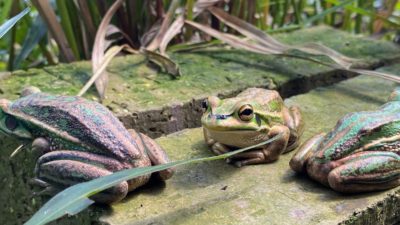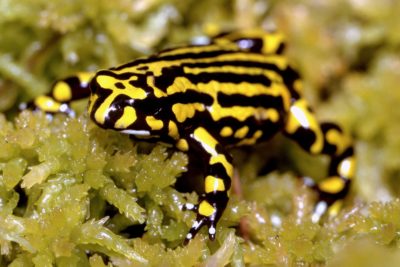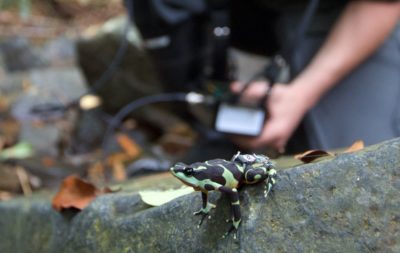Scattered across one zoo and two sanctuaries in Australia, a couple of thousand northern corroboree frogs wait for science to advance. The captive-bred frogs — critically endangered — fill an important role: As long as they survive, their species won’t go extinct. “It’s an insurance population,” says Ben Scheele, a wildlife ecologist at the Australian National University in Canberra. “We’re buying time.”
The northern corroboree frog, native to Australia, almost vanished in the 1990s, declining along with other frog species around the world. In 1998, researchers identified the culprit as a type of chytrid fungus called Batrachochytrium dendrobatidis (Bd), considered today by many experts to be the most lethal wildlife pathogen in recorded history. The fungus has infected more than 500 species of amphibians, mainly in the Americas and Australia, and wiped out as many as 90 species. Often when a pathogen kills off its host species, it dooms itself to the same fate. But because Bd can infect so many different species, disease ecologists say that it’s unlikely to disappear anytime soon.
Now, decades after the initial die-offs, scientists from Australia to Panama are taking stock of the survivors and asking how captive-bred frogs could be safely reintroduced to the wild. While a global solution remains out of reach, researchers are focusing on more targeted efforts that have the potential to help small populations recover. Possible solutions include everything from treating frogs with a sort of vaccine, to relocating them to Bd-inhospitable habitats, to setting up frog refugia — tiny tents over clay bricks where higher temperatures can kill the fungus the frogs carry.
“Chytrid will cause more species’ extinctions unless we do something about it,” says an Australian researcher.
“Chytrid will cause more species’ extinctions unless we do something about it,” says Scheele. “While that’s sort of depressing in one sense, it’s also motivating, because we know that there are things that we can do.”
An aquatic fungus, Bd swims to the skin of a host, where it releases compounds to suppress the frog’s immune response and then feasts uninterrupted on its skin. Over time, the frog’s motor functions begin to falter, and it loses the ability to breathe. The final blow is a heart attack, triggered by a depletion of electrolytes.
“To see a frog die of chytrid is probably the worst experience I’ve ever had,” says Anthony Waddle, a conservation biologist at Macquarie University in Sydney, Australia. “You’re watching the soul of nature leave it.”
A pathogen’s success usually depends on three factors: the susceptibility of its host; its lethality to its host; and the suitability of the host’s environment. Like Covid-19 in humans, a Bd fungal infection can affect individuals very differently, even within the same species. By figuring out the secret behind an individual’s survival, researchers hope they might be able to replicate those conditions for other frogs and tip the odds in their favor.
For instance, Scheele noticed that the few northern corroboree frog populations still surviving in nature have something in common: They all live at low elevations, where the climate is warmer and dryer than the mountaintops where some populations once lived. It turns out that despite its deadliness, Bd is actually quite fragile: the fungus prefers cool, moist areas, and it can’t grow well above roughly 28 degrees C (82 degrees F). For the northern corroborees, which are locally extinct in most of their range, changing the host’s environment could make a difference.
To test this idea, Scheele and his colleagues, in 2020, released several hundred captive-bred frogs in a warm, dry site just on the edge of the frogs’ historical range, then returned a year later to look for them. Finding frogs often poses a logistical challenge, but the inch-long northern corroborees have a quirk that makes them easy to find: simply call out “Hey frog!” in a deep voice, and the frogs will respond with a ribbit. While some of the frogs that Scheele and his team found were infected with Bd, they counted approximately 70 survivors, which was notable for a species that had been nearly wiped out in most other areas.
Some researchers are looking at ways to manipulate the environment itself rather than move the frogs. Waddle found that by covering clay bricks with a mini-greenhouse, he could easily create hotspots of 30 degrees C (86 degrees F) and higher. Green and golden bell frogs, which like to nestle in small spaces, will climb inside the tents of their own accord, killing the Bd on their skin as they warm up.
“We know it works in the lab,” a scientist says of one intervention. But “dumping it into the field is a whole different thing.”
Waddle’s team plans to apply for funding to support the placement of these shelters along the east coast of Australia. The low-tech environmental interventions are inexpensive (about $34 each), but they require substantial time and labor to set up and monitor. Still, conservationists are “just desperate to keep these frogs there,” says Waddle. “They’re going to try anything to do it.”
Others are focused on manipulating the frogs themselves. In 2014, disease ecologist Taegan McMahon made the cover of Nature after discovering that exposing several species of frogs to Bd prompts an immune response that protects them from future infection. Ideally, McMahon thought, you could vaccinate a frog without putting it through any infection at all. So it was exciting when frogs acquired the same resistance after exposure to dead Bd. Better yet, a similar effect was achieved when bathing the frogs in a solution of metabolites, or chemicals, released by the fungus. There was no need to treat the frogs with the pathogen at all, either dead or alive.
“We know it works in the lab. We know it works extremely well,” says McMahon, now affiliated with Connecticut College. But “dumping it into the field is a whole different thing.”
The life cycle of Batrachochytrium dendrobatidis. Brian Gratwicke via Flickr
To find out how Bd metabolites might affect other species and ecosystems, McMahon’s former student KM Barnett, now at Emory University, last spring mixed Bd metabolites with water and poured them into small ponds in a California nature reserve, then returned a few months later to test metamorphosing tadpoles’ levels of Bd. She also tested other invertebrates living in the pond to see how they’re affected by the metabolites.
One caveat, Barnett notes, is that metabolites are really just a prophylactic option, because they don’t effectively treat frogs that have already been infected. That suggests that correct timing, in addition to dosage, is critical for this treatment to work. She expects to finish analyzing the samples this spring.
Bathing frogs in solutions of beneficial bacteria, also known as probiotics, can also help them resist chytrid. But which bacteria are helpful? In 2008, disease ecologist Vance Vredenburg, of San Francisco State University, discovered that mountain yellow-legged frogs that made it through a Bd infection all shared a species of bacteria on their skin called Janthinobacterium lividum, which naturally produces a purple antifungal chemical.
In 2010, Vredenburg bathed some mountain yellow-legged frogs in a J. lividum solution and others in pond water, then released them in the Sierra Nevada. Upon his return a year later, he found none of the pond-water frogs, suggesting they had died — but he did find 39 percent of the frogs that had been treated with bacteria. It was the first field evidence that probiotics might work.
The long-term hope is that reintroduced frogs would eventually reach a point where their numbers are self-sustaining.
Since then, scientists continue to experiment, with varying success. When a researcher in central Panama tried J. lividum on harlequin frogs, which had been hit hard by Bd in 2009, the probiotic didn’t work, no matter how many different ways he tried it. In her lab at the University of Massachusetts, Amherst, ecologist Molly Bletz has identified other types of bacteria that resist Bd on frogs native to Madagascar.
In 2012, Jamie Voyles, a disease ecologist at the University of Nevada, Reno, found that harlequin and other frogs in Panama seemed to be recovering — all on their own — from Bd infections. But tests in the lab showed that the Bd on the frogs’ skin was just as lethal as it was when the outbreaks started. Pathogens can become less deadly over time. But in Bd’s case, some frogs were simply becoming resistant to it.
No one has yet explained the frogs’ resistance, but Voyles suspects it’s related to a change in the chemistry of their skin secretions, which have antimicrobial properties. It’s possible that those secretions have evolved to become more potent, and Voyles and colleagues are working to figure out the mechanism involved. But the frogs’ resistance suggests one way that selective breeding for survivability could help raise a generation of frogs that naturally have a better immune response to Bd — something that conservation biologist Brian Gratwicke has started to do at the Smithsonian Tropical Research Institute.
Smithsonian researcher Blake Klocke uses a radio transmitter to track a harlequin frog. Brian Gratwicke
Another option is to identify genes related to resistant frogs’ skin secretions and then genetically engineer other species with those genes. Biologist Tiffany Kosch of the University of Melbourne is currently looking for heritable resistance in the southern corroboree frog. The gene editing would be targeted specifically to this resistance, so she says she’s not worried about potential impacts on other species. Asked about unintended negative consequences for the host itself, she said, “I don’t see how our situation can really make things any worse for these frogs.”
Kosch emphasizes, though, that genetic engineering should be a last resort, because it’s expensive, challenging to execute, and can reduce genetic diversity in the host species.
Researchers say that while there’s no silver bullet for Bd infections, there are a lot of bullets. Each intervention can slightly increase frogs’ ability to survive a Bd infection. Using multiple interventions for the same population of frogs — say, vaccinating selectively-bred frogs and placing them in an optimized environment — could keep them from teetering over the brink into extinction. The long-term hope is that reintroduced frogs would eventually reach a point where their population numbers are self-sustaining without the constant intervention of researchers.
While proposed solutions might help isolated populations, “that’s going to do nothing for ubiquitous large populations.”
In December, scientists announced the rediscovery of several species of harlequin frogs in Panama that were thought to be extinct. It was exciting to find the frogs alive, but their numbers are still worryingly low. Small populations are generally at increased risk of fizzling out to disease — not just because there are fewer individuals to kill but because they are more likely to breed with close relatives, which decreases their genetic diversity and thus their ability to adapt to environmental change, says David Wilkie, an ecologist at the Wildlife Conservation Society.
“Chytrid is a global problem across a vast area,” Wilkie says. While the current proposed solutions may help these small, isolated populations, “that’s going to do nothing for ubiquitous large populations, other than hoping that nature allows a few of those critters to survive.”
For many frog researchers, that hope is enough. On his desk in San Francisco, Vredenburg keeps a jar of dead frogs he collected during his years of fieldwork in the Sierra Nevada, where he saw tens of thousands of dead mountain yellow-legs. “I definitely have plenty of reasons to not be an optimist,” he says, glancing toward his display. And yet he and other ecologists and conservation biologists remain optimistic. The field is abuzz with new ideas, he says, and young ecologists are bringing hope and energy. “We are actually more in control than we imagined. It’s more a matter of: Are we going to get our act together or not?”
Correction, February 22, 2023: An earlier version of this article incorrectly spelled the name of Vance Vredenburg of San Francisco State University. It is Vredenburg, not Vredenberg.






